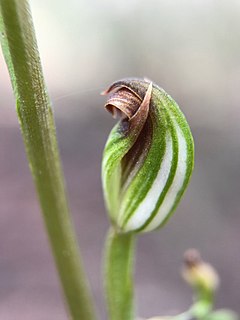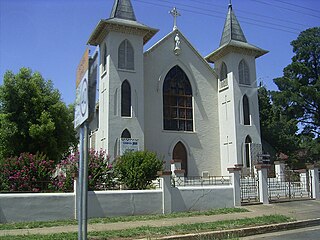
Pterostylis coccina, commonly known as the scarlet greenhood, is a species of orchid endemic to eastern Australia. As with similar greenhoods, the flowering plants differ from those which are not flowering. The non-flowering plants have a rosette of leaves flat on the ground but the flowering plants have a single flower with leaves on the flowering spike. In this species, the rosette leaves are relatively large and dark green, and the flowers are white, and bluish-green or red. It grows in New South Wales and north-eastern Victoria.

Pterostylis atrans, commonly known as the dark-tip greenhood or blunt-tongue greenhood, is a species of orchid endemic to south-eastern Australia. As with similar greenhoods, plants in flower differ from those that are not flowering. The non-flowering plants have a rosette of leaves flat on the ground, but the plants in flower have a single flower with leaves on the flowering spike. In this species, the flower is green and reddish brown with a protruding sinus and small club-like tips on the ends of the lateral sepals.

Pterostylis lingua, commonly known as the large-lipped rustyhood, is a plant in the orchid family Orchidaceae and is endemic to south-eastern Australia. It has a rosette of leaves and up to ten dark reddish-brown flowers with translucent "windows" and a blackish, insect-like labellum.

Pterostylis smaragdyna, commonly known as the emerald-lip leafy greenhood, is a plant in the orchid family Orchidaceae and is endemic to south-eastern Australia. Flowering plants have up to ten translucent green flowers with darker green markings. The flowers have an insect-like labellum which is green with a darker green mound at the "head" end. Non-flowering plants have a rosette of leaves but flowering plants lack the rosette, instead having five to seven stem leaves.

Pterostylis squamata, commonly known as the southern rustyhood or ruddyhood, is a plant in the orchid family Orchidaceae and is endemic to south-eastern Australia. Flowering plants have up to ten translucent green flowers with reddish-brown markings and a hairy, insect-like labellum. Non-flowering plants have a rosette of four to eight egg-shaped leaves. This species is very similar to Pterostylis rufa which has a narrower labellum and other minor differences.

Pterostylis vittata, commonly known as the banded greenhood or green-banded greenhood, is a plant in the orchid family Orchidaceae and is endemic to the south-west of Western Australia. The plants either have a rosette of leaves on a short stalk in the years when not flowering or stem leaves on a flowering spike. When flowering, it has up to about twenty five flowers which are translucent green with darker green stripes. It was formerly thought to occur in South Australia and Victoria but those collections are now thought to be of Pterostylis sanguinea.

Pterostylis woollsii, commonly known as the long-tailed rustyhood, is a plant in the orchid family Orchidaceae and is endemic to eastern Australia. It has a rosette of leaves at its base and up to six transparent flowers which have unusually long tips on their lateral sepals and a reddish-brown, insect-like labellum.

Pterostylis rubescens, commonly known as the blushing tiny greenhood, is a species of orchid endemic to south-eastern Australia. As with similar orchids, the flowering plants differ from those which are not flowering. The non-flowering plants have a rosette of leaves but the flowering plants lack a rosette at the base and have up to eighteen tiny green, white and brownish flowers.
Pterostylis chaetophora, commonly known as the Taree rustyhood, tall rusthood or ruddy hood is a plant in the orchid family Orchidaceae and is endemic to eastern Australia. It has a rosette of leaves at its base and up to twelve reddish-brown flowers with translucent "windows" and a fleshy, reddish-brown, bristly, insect-like labellum.
Pterostylis ciliata, commonly known as the hairy rufous greenhood, tall rusthood or hairy rustyhood is a plant in the orchid family Orchidaceae and is endemic to the south-west of Western Australia. It has a relatively large rosette of leaves at its base and up to eight or more green and brown flowers which lean forward and have a small, fleshy, insect-like labellum covered with hairs.
Pterostylis erythroconcha, commonly known as the red shell orchid, is a species of orchid endemic to South Australia. As with similar orchids, the flowering plants differ from those which are not flowering. The non-flowering plants have a rosette of leaves but the flowering plants have a single flower with leaves on the flowering spike. This greenhood has a white and green flower with reddish brown markings and a long, fleshy, curved labellum.
Pterostylis excelsa, commonly known as the tall rustyhood, or dry land green-hood is a plant in the orchid family Orchidaceae and is endemic to South Australia. It has a rosette of leaves and when flowering, up to twenty green or brown flowers which lean forward and have a thick, fleshy, partly hairy, insect-like labellum.
Pterostylis insectifera, commonly known as the insect-lipped rufous greenhood, or leaden rustyhood is a plant in the orchid family Orchidaceae and is endemic to the south-west of Western Australia. Both flowering and non-flowering plants have a relatively large rosette of leaves. Flowering plants have a similar rosette and up to eight or more flowers which have long, stiffly-held lateral sepals and a protruding, insect-like labellum.
Pterostylis mitchellii, commonly known as Mitchell's rustyhood, is a plant in the orchid family Orchidaceae and is endemic to eastern Australia. Both flowering and non-flowering plants have a rosette of leaves and flowering plants have up to fifteen flowers which have wide flanges on the petals and an insect-like labellum with a white "head".
Pterostylis ovata, commonly known as the Gawler Range rustyhood, is a plant in the orchid family Orchidaceae and is endemic to South Australia. Both flowering and non-flowering plants have a rosette of leaves and flowering plants have up to six flowers which have transparent flanges on the petals and a striped, insect-like labellum.
Pterostylis procera, commonly known as the short-lipped greenhood, is a species of orchid endemic to Queensland. It has a rosette of leaves and when flowering a single translucent white flower with green and reddish markings and a labellum which does not protrude through the lateral sepals.

Pterostylis pusilla, commonly known as the tiny rustyhood is a plant in the orchid family Orchidaceae and is endemic to southern Australia. It has a rosette of leaves and up to nine relatively small green and reddish-brown flowers with translucent white "windows" and a dark brown, insect-like labellum.
Pterostylis saxicola, commonly known as the Sydney plains rustyhood, or Sydney plains greenhood, is a plant in the orchid family Orchidaceae and is endemic to New South Wales. It has a rosette of leaves at its base and up to ten reddish-brown flowers with translucent "windows", relatively wide lateral sepals with short-pointed tips and a dark brown, fleshy, insect-like labellum.
Pterostylis stricta, commonly known as the northern greenhood, is a species of orchid endemic to Queensland. It has a rosette of leaves and when flowering a single translucent white flower with green lines, a reddish-brown tip and a curved, protruding labellum.
Pterostylis xerophila, commonly known as the desert rustyhood, is a plant in the orchid family Orchidaceae and is endemic to South Australia. Both flowering and non-flowering plants have a relatively large rosette of leaves. Flowering plants also have up to eight translucent white, green and reddish-brown flowers with an insect-like labellum.



















